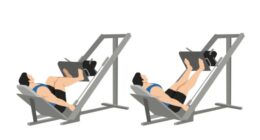If you spend all day working at a computer, either in an office or at home, you almost certainly spend too much time sitting down. You know you should at least stretch your legs every hour, since a sedentary lifestyle has been linked to everything from high blood pressure to cancer, but even that’s a struggle. And when you do rise to the challenge, it’s only to use the toilet, get a cup of coffee or look for some biscuits.
I’m not judging you. This is my life, too. I work out most mornings, but then I slump for eight or nine hours. I need a run, I tell myself, but even with a proper lunchbreak it’s hard to squeeze one in, once you add showering and changing time. So I just sit there, joints seizing up, stewing in my own frustration.
There is another way, though. Even if you can’t fit a full workout into the 9-to-5, you can probably manage a few exercise “snacks” – enough to get your muscles moving and your pulse racing.
We’ve put together a menu with the help of Sarah Aarons, a personal trainer and fitness instructor based in Crystal Palace, south London. None of her suggestions require any special equipment, and we’ve highlighted the ones that are least likely to get your workmates gawping if you do them in the office.
Aarons has broken the exercises down to focus on the lower body (legs and bum), upper body (shoulders, chest, arms), core (everything in between) and cardio (heart and lungs). The dividing lines are a little blurred, since many exercises work more than one area, and almost anything can be cardio if you do it fast enough – but if you cover all four bases you’ll end up with a good all-body workout.
Try to fit in as many “snacks” as possible during the day. The suggestions below should each take you two or three minutes. If you get a longer break, combine two, three, even four snacks. Variety is the key: don’t just work one area of your body every single time, or repeat the same handful of exercises. And think of the options below as a jumping-off point. There’s a lot more that you can do at work or at home with little or no equipment.
You may want to think about your wardrobe, though. As these photos show, it is just about possible to enjoy an exercise snack when you’re in traditional office drag. But it’s a lot easier if you dress for the occasion.
First snack of the day: 2-3 minutes of cardio
Aim for two or three exercises, with short breaks in between. The goal is to get your heart and lungs working, so don’t be afraid to push yourself a little.
Most office-friendly: Stair runs/walks
“Stairs are a great way to add intensity to a workout,” says Aarons, who runs outdoor classes on Crystal Palace Park’s long flights of stone steps. For an indoor version, simply run or walk up your work or home stairs as fast as you can safely go, maybe channelling Sylvester Stallone on Philadelphia’s “Rocky steps”. Once you hit the top, walk carefully down, and repeat.
Jumping jacks
Stand with your feet together and your arms by your side. Jump your feet wide apart, while raising your arms above your head, keeping them straight. Quickly jump your feet back together and lower your arms. Repeat.
For a gentler, low-impact version, step your feet out to the sides, one at a time, rather than jumping them, while simultaneously raising your arms.
Burpees
Starting with your feet hip-width apart, squat down and place your hands on the floor in front of you. Jump your feet back to a “high plank” position, so your body forms a straight line from your shoulders, through your hips and knees to you feet (see core section below for more detail). Then immediately jump your feet back towards your hands again. Jump up as fast and as theatrically as possible. Squat down again to repeat.
To make this less intense, just stand up at the end of each burpee instead of jumping, and step the feet back into and out of your plank rather than jumping them.
Jump squat
Start with a standard squat (see lower body below), with your arms by your sides. Jump upwards, extending your legs fully. Land softly on bent knees, go straight into another squat and repeat.
Mountain climbers
Start in a high plank position (see core section) and bring one knee to your chest as fast as you can, and then the other, as if you’re running.
Plank jack
From a high plank, jump both feet apart, then back together again. Repeat.
Second snack: 2-3 minutes of lower body
Again, pick two or three exercises. Take everything slowly to start with, so you can concentrate on moving correctly. For everything other than cardio, control is usually more important than speed. Your muscles are getting a workout whether they’re moving you or simply holding you up.
Standard squat
“Squats are a really good all-round exercise for the lower body,” says Aarons. “Although they can seem daunting, they’re very accessible.” This basic version is your gateway to dozens of variations.
Stand with your feet parallel, hip-width apart, then lower your bum towards the ground as far as you can comfortably go, keeping your weight mostly in your midfoot and heels rather than in your toes. Your chest should be upright rather than bent forward. It helps to look ahead rather than down. You can cross your arms over your chest, or clasp your hands together, or stick your arms out in front of you, sleepwalker-style … just don’t rest them on your thighs. Come back to standing and repeat. Or stay down for a squat hold.
Split squat
Start with your feet parallel and hip-width apart, then take a big step back, resisting your natural tendency to drift your foot in towards the centre of your body. Keeping your torso and chest upright and your gaze ahead, sink down as far as you comfortably can, then come back up again. Repeat. To make this more challenging, put your rear foot up on a step, or a low chair (not the type on castors), or a box of printer paper.
Most office-friendly: Wall sit
Stand with your back to a wall, feet hip-width apart, and sink down until your thighs are parallel to the floor. Keep your back, head and bum against the wall, and avoid resting your hands or arms on your thighs. Hold the pose for as long as you can. Even 30 seconds will feel like an achievement.
Glute bridge
Lie on your back, bend your knees and place your feet flat on the ground, hip-width apart and as close to your bum as you can get them. Your arms should be at your sides, palms down.
Tighten the muscles of your midsection by pulling your belly button towards your spine. This is known as engaging your core.
Squeeze your glutes and push through your heels to lift your hips off the ground. Try not to tense your shoulders or pull them forward. Continue lifting until your body forms a straight line from your shoulders through your hips to your knees. Hold for a second or two, then gently roll your back and bum down. Repeat.
Third snack: 2-3 minutes of upper body
Again, pick two or three exercises. Yes, even the push-ups!
Basic push-up
“A lot of people tell me they can’t do a push-up,” Aarons says. “You can. You might just need to modify it so you’re not pushing your full body weight.”
For the unmodified form, start in a high plank position (see core if necessary). Splay your elbows out a little and slowly lower your body until your chest is almost touching the ground, then lift it up again. Try to keep your core engaged and resist either sagging or lifting your bum too high. Repeat.
To make things a little easier, start in high plank again but drop your knees before starting the movement; this is known as a knees-down pushup. To make it easier still, start on all fours and keep your bum up while moving your upper body; this is a box press.
Once you’ve mastered the basic form, make things harder with a decline push-up, with your feet raised – on a low table, say, or a box of printer paper.
Tricep dips
Find a desk, or a chair that doesn’t swivel, and sit on the edge of it, hands next to your thighs, gripping the front of the seat. Your elbows and upper arms should be in by your body rather than flaring out. Walk your feet out a step or two so your bum is just off the edge.
Engage your core and bend your elbows to lower your body down. Keep them pointing straight back.
Lower yourself until your elbows form a right angle. Push back up to your starting position and repeat.
Most office-friendly: Shoulder circles
Stand nice and tall, arms raised at your sides like the wings of a plane, palms down. Draw small circles with your hands, first in one direction for 20-30 seconds, then in the other, while moving your shoulders as little as possible. It starts out easy but by the end your upper arms will burn.
Fourth snack: 2-3 minutes of core
Pick two or three exercises.
Single-leg deadlift
If you do yoga, you’ll recognise this as a version of warrior three. Start with your feet hip-width apart and shift your weight on to one leg, keeping a slight bend in that knee. Engage your core and begin to hinge forward at the hips, extending your raised leg straight back behind you and reaching your arms down towards the ground. Tilt as far forward as you can, keeping your leg in line with your spine, so there’s a straight line from your shoulders through your bum to your heel. (Viewed from the side, you should look like a capital T.) To help yourself balance, keep your gaze locked on one point on the floor. Return to the starting position, switch legs and repeat. Don’t be surprised if one side is more wobbly than the other.
High plank
Get on all fours, with your hands directly underneath your shoulders and your knees underneath your hips. Keep your arms straight and step your feet out behind. Engage your core and keep your bum down so your body forms a straight line from your shoulders through your hips and your knees to your heels. If you have a more experienced friend, get them to tell you if your bum has crept up. Hold for as long as you can. A minute is very good if you’re starting out.
If all this is a struggle, which it may be, lower your knees so they are taking some of the weight.
Low plank
Like a high plank, except your forearms are resting on the ground, rather than just your hands.
Most office-friendly: Single-leg stand
Standing nice and tall, raise one leg in front of you (ideally straight), as high as it can go. Hold for as long as possible. To help your balance, keep your gaze locked on one point.



